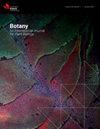哺育植物和放牛是否有助于恢复帕拉托尔的波多卡普森林?
IF 1
4区 生物学
Q3 PLANT SCIENCES
引用次数: 0
摘要
在阿根廷西北部的新热带云雾林中,养牛业历来是主要的经济活动,对生态系统造成了潜在的负面影响。了解影响树木再生的因素对放牧区的植树造林工作至关重要。鉴于对南永加斯山地森林中一种独特的裸子植物--Parlatore's Podocarpus(Podocarpus parlatorei Pilg.)在围栏内,无论是否有护树植物,树苗的存活率都是 100%。然而,在隔离区外,与护苗植物一起生长的树苗成活率要高出 19.5 倍。在围栏内,与护苗植物有联系的树苗的生长率更高。护苗对生长的积极影响在围栏内外相似。我们首次观察到牛对帕拉托尔荚果的啃食和践踏,这凸显了该物种面临的一个以前未曾记录的威胁。我们的研究结果为生态恢复提供了宝贵的见解,有可能建议在难食植物附近战略性地种植树苗,并考虑在关键区域排除牛群,以提高南永加斯山地森林长期恢复的成功率。本文章由计算机程序翻译,如有差异,请以英文原文为准。
Do nurse plants and cattle exclusion help restore Parlatore’s Podocarp forest?
In the Neotropical cloud forests of northwest Argentina, cattle ranching has been historically the primary economic activity, with potential negative impacts on the ecosystem. Understanding factors influencing tree regeneration is crucial for reforestation efforts in grazed areas. Given the limited understanding of Parlatore's Podocarp (Podocarpus parlatorei Pilg.) regeneration ecology, a unique gymnosperm species in the Southern Yungas' Montane Forest, we evaluated the growth and survival of its saplings for one year after planting them both inside and outside an exclosure, and in association with or without unpalatable nurse plants. Inside the exclosure, sapling survival was 100%, regardless of nurse plants. However, outside the exclosure saplings associated with nurse plants had 19.5 times higher survival probability. Growth rates were higher inside the exclosure and for saplings associated with nurse plants. The positive effect of nurse plants on growth was similar inside and outside the exclosure. Cattle browsing and trampling on Parlatore's Podocarp were observed for the first time, highlighting a previously undocumented threat to the species. Our findings offer valuable insights for ecological restoration, potentially suggesting strategic sapling planting near unpalatable plants and considering cattle exclusion in key areas to enhance long-term restoration success in the Southern Yungas' Montane Forest.
求助全文
通过发布文献求助,成功后即可免费获取论文全文。
去求助
来源期刊

Botany
生物-植物科学
CiteScore
2.20
自引率
9.10%
发文量
48
期刊介绍:
Botany features comprehensive research articles and notes in all segments of plant sciences, including cell and molecular biology, ecology, mycology and plant-microbe interactions, phycology, physiology and biochemistry, structure and development, genetics, systematics, and phytogeography. It also publishes methods, commentary, and review articles on topics of current interest, contributed by internationally recognized scientists.
 求助内容:
求助内容: 应助结果提醒方式:
应助结果提醒方式:


